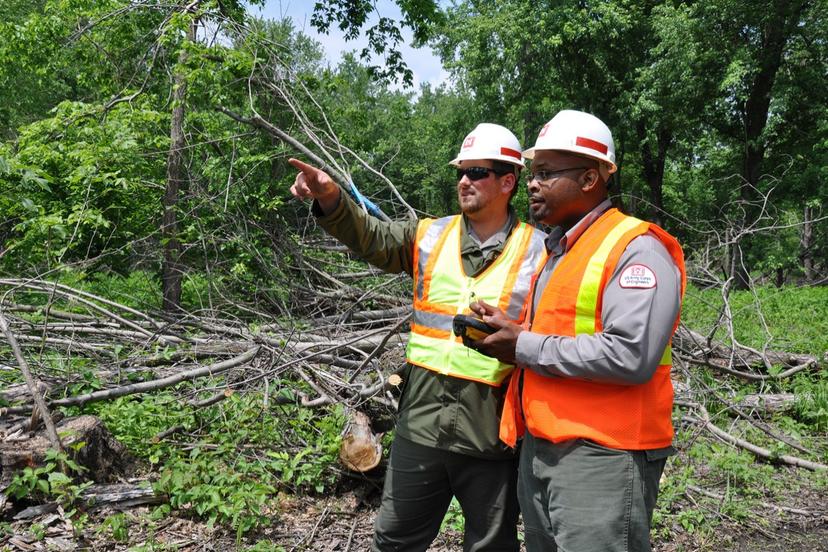Forestry and Forest Products

Background
You can't get away from it. It's in your home. It's in your school. It's in your books and your paper and even your cereal boxes. Because wood is used for so many different purposes, you probably come in contact with it, in one form or another, several times every day.
Wood is a primary product of the forest. It is used to build houses, furniture, flooring, shipping containers, and many other products. It is also used to produce the pulp needed for making paper. Wood that is used to make commercial products is referred to as lumber. There are many steps, or lumbering processes, that must occur in order to turn a tree into a commercial product. These steps include the harvesting and removal of trees, the conversion of the raw material into finished products, and the marketing and distribution of these products. This article primarily focuses on the lumbering industry.
Throughout history, wood has been used as a source of heat and as material for shelter and other types of construction. The Phoenicians and other early civilizations used wood to build boats and rafts and to make the pilings used in docks and piers. The early Romans used thin slices of wood called veneer for ornamental and other purposes. Today veneer is still used in this manner. As civilizations advanced technologically, the uses of wood changed to meet the needs of the day. For example, as the railroad industry grew, wood was used in the crossties of railroad tracks. With advances in wood chemistry, wood was used in clothes, plastics, and a host of other products. In many less developed countries wood is still a primary source of fuel.
When the Pilgrims first arrived, forests covered huge areas in North America. These early settlers cleared the forests so they could build shelters and farm the land. As settlements expanded westward, large portions of the forested area were cleared, and most of the trees suitable for prime lumber were removed. As the population grew and much more land was cleared during the 19th century, foresighted people began to realize that unless forests were managed wisely, they would disappear. Laws enacted by Congress and state governments around this time slowed the consumption of the forests. In 1905, the U.S. Forest Service was established in the Department of Agriculture, and assumed responsibility for the newly proclaimed national forest reserves, renamed the National Forests in 1907.
Most of the nation's lumber production comes from commercial forests; about half a billion acres of commercial forests throughout the United States produce 90 percent of the nation's lumber requirements. In the last several decades, there have been vast improvements in forest management techniques in the United States, portions of Europe, and other areas. In earlier years, loggers would simply cut down all the trees in a particular area, often destroying vast forests. Foresters and others came to realize that the forests had to be managed, however, and trained forest scientists were enlisted to protect the forests from fire, insects, and diseases, and to manage the forests so that only selected types and numbers of trees were removed. Many lumber companies also began to maintain tree nurseries to replant the timberlands. Young trees from the nurseries are planted where trees have been harvested. Today, the United States has 20 percent more trees than it did in 1970.
Although forests are now better managed, there is still a degree of controversy regarding foresting techniques. Many old-growth forests support wildlife and plant life that cannot exist in any other ecosystem. In the Pacific Northwest and other parts of the country, there is a continuing debate over how much old-growth forest should be cut down for economic purposes and how much old-growth forest should be retained for environmental reasons. In the United States, the lumber industry is primarily located in the Northwest, the Northeast, the South, and around the Great Lakes.
Lumber is divided into two main classes: hardwood and softwood. These terms do not refer to the actual hardness or softness of the wood, but rather to the type of tree from which the lumber originates. Hardwoods come from deciduous trees, which have broad leaves that fall off in autumn. Hardwoods used for lumber include oak, birch, maple, and elm. Softwoods, also called evergreens, come from conifers. Softwoods used for lumber include pines, Douglas firs, redwood, and spruce.
Lumber is sawed to a variety of widths and thicknesses depending on its final use. Factory and shop lumber is recut in the manufacture of furniture, baseball bats, and other objects. Any piece of lumber less than 5 inches thick is considered yard lumber, which is used for general building purposes. Timbers are large pieces more than 5 inches wide or thick. Timbers are widely used in the construction industry.
